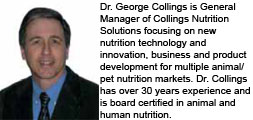Clarifying categories and claims in pet food

There are hundreds of pet food brands globally with dozens of product types within each brand. Each brand tries to distinguish itself with noticeable packaging, specific ingredients, good nutrition and highly consumable products.
By George Collings
Years ago, the choices were very simple: A good quality, nutritious, round dog food or a star-shaped cat food that tasted good. There may have been some differences in shape, colour and flavour types, but nutritionally there was great similarity between brands. There were additional options for puppies/kittens and breeding females, for weight management and higher energy needs. In the early 1980s, two new options entered the market: Super-premium branded products that were higher energy and nutrient-dense providing higher fat, protein, calories and digestibility and value products made by smaller, regional companies offering alternative price-sensitive brands compared to the premium brands by adding more fibre (filler) and some lower quality ingredients.
Higher level of nutrition
Volumes in both sectors grew dramatically at the expense of the existing ‘Premium’ brands. Super-premium products had unique, new ingredients, more digestible protein sources, added vegetable oil and produced smaller, firmer stools. The overall focus was a higher level of nutrition and better health. They brought more science, marketing flair and health claims. Super-premium products appealed to the veterinarians and to the new, growing large-retail pet stores that were just beginning to grow. Value products used multiple fibre sources at higher levels to reduce product cost which ultimately reduced the calories, digestibility and taste of the product while softening and enlarging the stool. Above all, value products were price alternatives to the premium brands which held most of the market. Value brands did not equal private label. Private label products were formulated to meet super-premium, premium and value levels of nutrition.
Product assessment
There are many ways to evaluate and categorise pet foods, which has increased over the years. Some products will meet nutritional needs for all-life stages or for specific life stages like growth, reproduction, lactation, senior or maintenance. Some products are specifically designed to help with allergy, dental issues, hip and joint care, sensitive intestinal tracts, skin and hair coat and weight management.
Products will be labelled for puppies or growth; for adults or maintenance; for seniors or maturity; light or less active. These products will be called bites, little bites, small bites, bits, kibbles and chunks.
They will come in multiple forms like dry, soft-dry, soft-moist, canned, pouched, chubbed or rolled, baked and raw. Adding various colours, shapes and levels of palatability further expands the many hundreds of potential products.
Product lifestyle claims
Some products will meet lifestyle choices offering many claims. The first major change in pet foods occurred back in the early 90s with the launching of ‘natural’ pet foods. The natural definition was ill-defined at the time, but has been agreed to by the American Association of Feed Control Officials (AAFCO). The term natural is only acceptable in reference to the product as a whole if all the ingredients are not chemically synthesised. This would not include the vitamins, minerals and other trace nutrients. Many brand names have been launched using the words natural or nature in them to build an overall brand image of natural. Specific ingredient terms (natural antioxidants and natural flavours) were also used in products that were not completely formulated to be natural. Organic foods and food markets are growing rapidly (approximately 20% annually). The Organic Trade Association forecasts by 2025 organic products will be considered commonplace. Organic pet foods are relatively new to the marketplace, but are growing right along with human organic foods as owners want to offer the same quality to their pets. A survey of people that purchased organic food products revealed the reasons for purchase:
• Avoid pesticides and antibiotics (70%)
• Freshness (68%)
• Health and nutrition (67%)
• Avoid GMO ingredients (55%)
The USDA (Department of Agriculture) has defined organic foods as ‘produced by farmers who emphasise the use of renewable resources and the conservation of soil and water to enhance environmental quality for future generations.’ There are additional requirements on antibiotics, hormones, synthetic fertilisers, pesticides, bioengineered ingredients and irradiation. The USDA makes no claims that organic foods are safer or healthier. The National Organic Standard Board recommended a pet food task force determine the requirements necessary for certifying a product as organic and what specific claims would be acceptable. Products may be labelled ‘100% Organic’ if they have 100% organic ingredients and additives, including processing aids.
Products may be labelled ‘organic’ if they have 95% organic ingredients and the remainder may be non-synthetic substances or synthetic substances on an approved list. Products may also be labelled ‘Made with Organic’ if they have 70% organic ingredients and the remainder is non-organic ingredients, non-synthetic or synthetic ingredients on an approved list of ingredients.
All products cannot include ingredients that are genetically engineered (GMO), produced using irradiation and other exclusions. While a lot of controls and steps are in place with organic foods, there is currently no evidence that organic foods are healthier and safer.
This is a ‘lifestyle’ choice made by the consumer based upon their own understanding of how organic ingredients are obtained.
Holistic
The term ‘holistic’ comes from the word ‘holism’ (from a Greek word meaning all, entire, total). The idea is that all the properties of a given system (biological, chemical, social, economic, mental, etc) cannot be determined or explained by the sum of its component parts alone. Instead, the system as a whole determines in an important way how the parts behave. Holistic living is living in harmony with ourselves, each other and nature. Holistic health is a term used in alternative medicine to describe a level of care that views the physical, mental and spiritual aspects of life as interconnected and balanced. How does this translate to holistic nutrition and holistic pet foods?
Holistic nutrition appears to be simply that which brings the best combination of holistic ingredients. This begs the question: What are Holistic ingredients? It might suggest that ingredients that are closer to nature are best (especially natural and organic ingredients).
However, upon careful and extensive review, there is no clear definition of what constitutes holistic in the pet food industry. Clearly, holistic ingredients will be natural and could be organic. The term holistic has a wide and varied set of definitions as established by the specific brand. There does appear to be a relationship with human nutritional research and human functional foods.
The ingredients used focus on newly found compounds from natural sources that have some level of physiological effect. If it is good for humans, it must be good for pets. Hundreds of books have been written suggesting dozens of potential health improvements or connections. While we cannot conclude that there is no physiological impact, we cannot conclude there is either. An example of this would be phytochemicals. There is a lot of research with a wide range of phytochemicals that are sold in the human food and supplement markets with claims towards immunity, health, antioxidants, cholesterol reduction, etc. While it is likely that many ingredients could have similar functionality across species, such claims need to be tested.
Anecdotal responses and field trials are poor alternatives to controlled research. In general, holistic pet foods use protein meals from unique sources and try to avoid grains if possible. Chicken fat stabilised with natural antioxidants is the most likely energy source plus vegetable oils of various kinds. Many holistic pet foods will use a variety of enzymes to improve digestion; herbs and spices for allergies, breath, etc; fruits with a high content of bioflavonoids for antioxidants and to improve kidney infections. Chelated or sequestered minerals will be used to provide minerals that are more available to the pet.
Meat free pet foods
As some pet owners have made lifestyle choices to avoid meat, milk or eggs (classified vegans), some want to offer the same to their pets. However, both dogs and cats prefer meat proteins over vegetable proteins in taste. Building a vegetarian pet food becomes a difficult task not only with balancing the nutrients well, but also offering something flavourful enough for pets to eat. Many vegetable proteins have negative odours/flavours to pets. Some products focus on ovo-lacto vegetarian definitions that allow the pet food to contain milk products, egg and even fish.
There is no physiologic data to suggest vegetarian pet foods are healthier for pets, but caution is warranted as formulation control is critical.
Other product claims
AAFCO has specific requirements for claims like ‘complete and balanced’, ‘perfect’, ‘scientific’ and ‘100% nutritious’. There are specific standards for lower calorie products (light, lite or low calorie).
There are specific standards for lean, low fat and reduced fat. All of these terms further define the claims along with marketing classifications (nutritional or lifestyle) to shed light on the level of quality in the product. However, none of these defines the level of quality standards used by the brand (set by the American Institute of Baking, ISO9002, HACCP, GMP, etc). Identifying all of these product classifications and claims is a confusing endeavour to anyone in the industry, but especially to the consumer. As an industry, we should endeavour to build acceptable product definitions to help pet owners better understand how our products differ and how good our products are.
How does a consumer make a choice?
Basically, the consumer can read the claims on the front of the package, the ingredient statement on the side or back panels (showing ingredients used in descending order), the guarantees (protein, moisture, fibre, fat and others), and if the product was actually fed to pets or not. All of this information only tells the consumer a little bit of information about the food.
A consumer will not be able to tell if the nutritional formulation is well-balanced and well-digested and has been prepared well. They will not be able to determine the nutritional knowledge and experience that went into the designing the product.
A consumer cannot tell if their pet’s hair coat will be glossy or dull; whether the product causes large or small stools; whether it causes loose or firm stools; whether the product causes bad breath or flatulence; or whether it just tastes good to their pet. Once a decision is made to purchase a food – it is only by trial that the pet owner will determine if they are satisfied with the performance provided by the nutrition and product expertise of the brand company.
Source: FeedMix vol 17 nr 4, 2009











